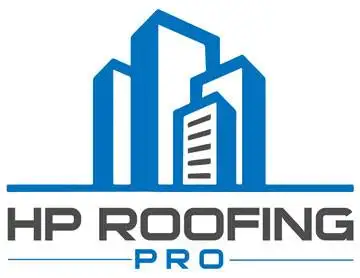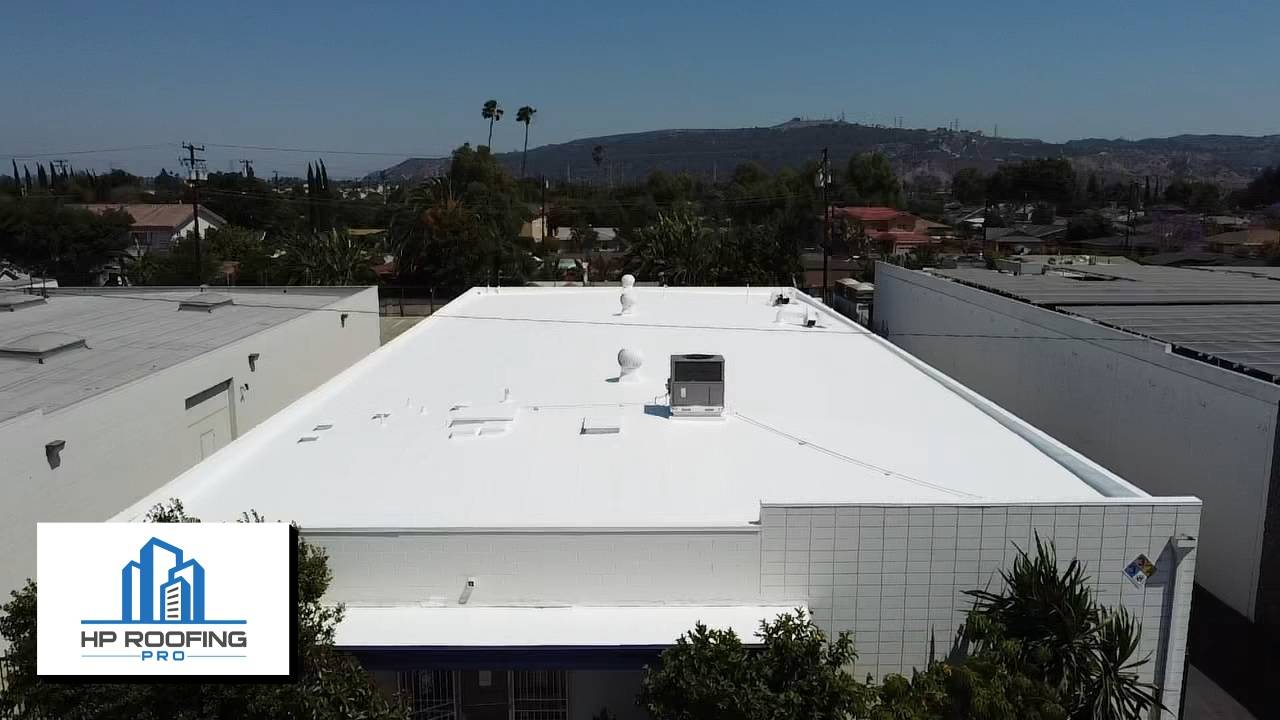Mon - Fri 7:00 am - 4:30 pm
601 South Palm Ave, Alhambra, CA 91803
Posted by thomas ferriere No Comments on Flat Roof Contractors, Installation, and Cost Guide for Los Angeles Roofing
Flat Roof Contractors, Installation, and Cost Guide for Los Angeles
Flat roofs are a popular choice for commercial buildings due to their low cost, durability, and ease of maintenance. However, the cost of installing a new flat roof can vary depending on several factors, including the size of the roof, the type of material used, and the complexity of the installation.
Here’s everything you need to know about flat roofing:
What Is a Flat Roof?
A flat roof is a type of roof that has no slopes or angles. It usually consists of a waterproof membrane laid over waterproof insulation boards. These boards have ballast rocks or gravel to add weight and durability to the structure.
Flat roofs can be excellent solutions for areas with little space available for traditional pitched roofs. This style of the roof also helps keep rainwater away from the walls.
Yet, they pose their own set of problems, which include heat loss and skylight visibility.
Flat Roof Pros
Like any other roof, commercial flat roofs have advantages and disadvantages. Let’s look at the benefits of flat roof installation:
- Low profile and low height or eaves
- Maximum water resistance even in extreme weather conditions
- Cheaper material cost
- Fewer roofing materials are needed
- A flat roof can last for decades
- Durable against leaks
- Less expensive than other types of roofs
- Longer service life compared to roofs with steep slopes
- Reduce building energy costs through airtightness and insulation during winter months
CONS
But flat roofs can also have disadvantages, for example:
- It is not aesthetically pleasing because the low slope does not match other adjacent pitched roofs on built structures.
- Requires extra precaution when it comes to strong winds or significant snowfall accumulation
In-Depth Analysis of Flat Roof Costs for Commercial Buildings in Los Angeles
The cost of installing a new flat roof on a commercial building is influenced by a myriad of factors that go beyond just the basic square footage calculations. This section provides a detailed breakdown, catering to the nuanced needs of knowledgeable building owners and managers.
- Size and Scale of Project: The overall size of the roof is a primary cost determinant. Larger roofs require more materials and labor, which increases the total cost. However, economies of scale can sometimes play a role, slightly reducing the cost per square foot for larger projects.
- Material Selection: The type of material chosen for the flat roof significantly impacts the cost. Options range from traditional built-up roofs (BUR) to modern materials like PVC, TPO, or EPDM rubber roofing. Each material has its price point, durability, and maintenance requirements. For instance, while EPDM may be more cost-effective upfront, PVC offers greater durability and energy efficiency, which could lead to long-term savings.
- Advanced Features: Incorporating advanced features such as high-quality insulation and state-of-the-art waterproof membranes can elevate costs. While increasing initial expenditure, these features can provide significant energy savings and long-term durability, which is especially important in climates with extreme weather conditions.
- The complexity of Installation: The complexity of the roof design and installation process also influences the cost. Factors such as the presence of existing structures, ventilation systems, and custom architectural elements can complicate the installation process, requiring more specialized labor and materials.
- Regional Cost Variations: Geographical location is critical in determining the cost. Areas with higher living costs, such as Los Angeles, generally see higher rates for roofing services. This is due to various factors, including labor costs, availability of materials, and local building codes and regulations.
- Contractor Selection: The choice of contractor can significantly impact the final cost. Experienced contractors specializing in high-quality installations may charge more, but this can lead to better workmanship and longer roof life, potentially reducing overall expenses in the long run.
- Maintenance and Lifetime Costs: It’s also important to consider the long-term maintenance and potential repair costs associated with different roofing types. A cheaper installation might lead to higher maintenance costs down the line.
In the Los Angeles area, where construction costs can be higher, prices for flat roof installations can range from $2 to $7 per square foot, but these can vary based on the above factors. For a more accurate and customized estimate, consulting with local experts who understand the specific challenges and opportunities of roofing in the Los Angeles climate would be best. Our comprehensive Los Angeles flat roof cost guide offers insights and deals tailored to the region’s unique needs.
Navigating the Complexities of Flat Roof Installation in Los Angeles: A Guide for Building Professionals
While installing a flat roof might seem straightforward at a glance, it involves a series of intricate steps and considerations that underscore the importance of professional expertise. This section is designed to give building owners and managers an advanced understanding of the installation process.
- Assessment and Planning: The initial installation phase thoroughly assesses the building’s structure. Professional roofers will evaluate factors such as load-bearing capacity, drainage requirements, and the existing roofing system (if applicable). This assessment is crucial in determining the appropriate materials and installation method.
- Material Selection: Choosing the right material for a flat roof is a complex decision, influenced by factors like the local climate, building usage, and budget. Materials range from traditional options like modified bitumen and built-up roofing (BUR) to modern alternatives like TPO, PVC, and EPDM. Each material has its specific performance characteristics, life expectancy, and maintenance requirements. In areas with heavy rainfall or extreme weather conditions, materials with superior waterproofing and durability are preferred.
- Installation Techniques: The installation process of a flat roof varies based on the chosen material. Techniques may include hot or cold application methods, fully adhered systems, mechanically attached systems, or ballasted systems. Each method has its advantages and considerations, such as insulation performance, wind uplift resistance, and ease of maintenance.
- Insulation and Waterproofing: Proper insulation is vital for energy efficiency, especially in climates with significant temperature fluctuations. Waterproofing layers, such as membranes, are essential to prevent leaks and water damage. Advanced waterproofing techniques might include using liquid-applied membranes or reinforced bitumen membranes for enhanced protection.
- Drainage Considerations: Effective drainage is critical in flat roof installation to avoid water pooling and subsequent damage. Professional installers will design a slight slope and strategically place drains, scuppers, or gutters to ensure proper water runoff.
- Compliance with Local Regulations: In regions like Los Angeles, roofing installations must comply with specific building codes and regulations. Professionals are well-versed in these requirements, ensuring that your roofing project adheres to all legal standards.
- Post-Installation Inspection and Maintenance Planning: After installation, a thorough inspection is conducted to ensure the integrity and quality of the roof. Additionally, professionals can provide guidance on a maintenance schedule, which is crucial for the roof’s longevity.
In conclusion, while installing a flat roof may appear simple, it involves a range of technical and strategic considerations. Professional roofers will walk you through this entire decision-making process. They’ll help you pick out materials that best suit your needs and can withstand heavy storms or months with little precipitation.
Why Are Flat Roofing Materials Different from Pitched Roofing Materials?
Flat roofs need special waterproof materials to protect the inside of your home from water infiltration and mold growth. These elements occur due to excessive moisture.
Remember, flat roofs don’t curve down like pitched roofs that drain runoff from the structure.
The reason there’s a difference in materials is due to what each part of the roof does. Asphalt shingles hang over the edges of roofs.
This way, they can withstand harsh weather like strong winds and rain or snow accumulations throughout the year.
In contrast, flat roofs don’t have any natural protection from wind. They’re just laid on top of the building with nothing hanging over them.
Comprehensive Overview of Flat Roof Materials for Commercial Buildings
When selecting flat roof materials, it’s crucial to consider factors such as durability, weather resistance, energy efficiency, and maintenance requirements. Here’s a detailed look at various options, including the innovative cool roof concept and the RainArmor system:
- Built-Up Roofs (BUR)
- Composition: Consists of multiple layers of asphalt paper, gravel, and tar.
- Advantages: Cost-effective option for many commercial buildings.
- Limitations: While economical, it offers limited protection against water damage and requires regular maintenance.
- Single-Ply Membrane
- Materials: Made of rubber or plastic, available in roll-out sheets or spray-on options.
- Benefits: Lightweight and adaptable to various roof designs.
- Considerations: Requires consistent maintenance and can be more costly to install.
- Metal Roofing
- Features: Known for weather resistance and energy efficiency, reflecting a significant portion of the sun’s heat.
- Ideal For: Areas prone to high winds and extreme weather conditions.
- Cool Roof Point: Metal roofs can be treated with reflective coatings to enhance their cool roof properties, significantly reducing energy costs in warmer climates.
- Wood Shingles or Curved Tiles
- Characteristics: Offer a distinct aesthetic appeal, especially for buildings with vintage styles.
- Benefits: Lightweight and versatile in design.
- Consideration: More suitable for specific architectural styles and may require more maintenance.
- Slate Tiles
- Composition: Made from real slate or high-density concrete.
- Advantages: Offers robust protection against weather elements.
- Installation: Due to their weight, they require professional installation and are more suitable for structures that can support heavier roofing materials.
- Tar and Gravel
- Similarity to BUR: It shares similarities with built-up roofs but offers enhanced leak protection.
- Application: Gravel provides additional protection, while tar acts as an adhesive.
- EPDM Rubber or Plastic Membrane
- Material: Composed of durable rubber or plastic.
- Flexibility: Allows for easy replacement of individual sections rather than the entire roof.
- RainArmor System: This type of roofing is compatible with the RainArmor system, providing an added layer of protection and enhanced durability, especially in regions with heavy rainfall.
- Cool Roof Systems
- Concept: Designed to reflect more sunlight and absorb less heat than standard roofs.
- RainArmor Integration: This can be integrated with systems like RainArmor for enhanced waterproofing and durability.
- Benefits: Reduced energy bills, improved indoor comfort during hot weather, and decreased roof temperature, extending roof life.
Let Your Trusted Contractor Install a Flat Roof for You Today in Los Angeles County
Are you building a new home and want flat roofing? Whether you want a new roof installed, repaired, or inspected in Los Angeles, HP Roofing Pro is here for you.
Our skilled team will offer a free inspection, design your flat roof, and install it at the best prices. We’ll also arrange better financing for your roof construction. Please reach out to us now to start your roof installation process.
Recent Posts
Categories
Recent Posts
Do you have any questions?
Contact us at The HP Roofing PRO office or submit a business inquiry online
Contact Us






